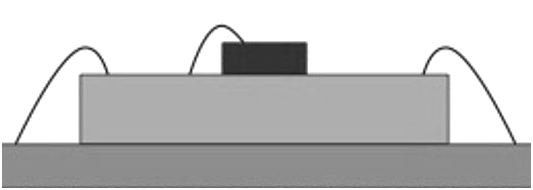Accurate clock signals are a prerequisite for reliable communication - whether by radio or by wire. With the ever-increasing demand for data transmission, the previous approach has reached its limit.
To integrate the clock generator into the microcontroller, Texas Instruments developed a film bulk acoustic wave (BAW) resonator that can be placed on top of the Si chip to form a package system.
This enables researchers and developers in all areas of Texas Instruments to achieve two goals. So far, they have optimized the design of the bulk wave resonator, which produces high quality high frequency oscillations - typically 1200 at 2.5 GHz - and it can be mounted in the housing with the silicon chip.
Volumetric resonators developed by Texas Instruments can be fabricated on silicon substrates using thin film technology. It consists of a piezoelectric layer between two metal electrodes and is surrounded by several layers that act as acoustic reflectors to limit mechanical energy, thereby forming a high quality resonator.
To date, most microprocessors use a clock signal whose frequency is given by an external crystal to produce an accurate clock signal.
Advances in the miniaturization of digital circuits mean that quartz can be considered the largest device in a microcontroller circuit. Until now, it has not been possible to miniaturize an external crystal equivalent to a digital circuit or integrate it with a chip in an IC package.
On the other hand, the RC or LC generator integrated in the microcontroller saves space. They can be integrated directly into the IC, but due to their high tolerance, they are only suitable for a few applications and are hard to be considered as a substitute for quartz.

Figure 1. A BAW resonator is placed on a Si chip and electrically connected to the semiconductor chip by wire bonding.
Although external MEMS generators are smaller than quartz and avoid their disadvantages, they still require extra space on the PCB. MEMS clocks integrated in the IC housing, such as the BAW resonator developed by Texas Instruments, provide a space-saving alternative.
Texas Instruments chose bulk wave resonator technology because it not only allows accurate clock signal generation, but the materials needed to build BAW resonators are also suitable for semiconductor manufacturing (Table 1).
Technology
|
Advantages
|
Disadvantage
|
Bulk Wave Resonator(BAW)
|
· Height Goodness , about 1000 at 2.5 GHzallows very small jitter.
· Height Resonance frequency of 2 GHz to 3 GHz allows it lots clock frequencies bydivision to generate , eg .
Can out throughthe 2.5 GHz signal of a BAW resonatorDivision 156.25 MHz, 125 MHz and 100 MHz won be .
· Very low RMS jitter not from the outsideaffected becomes : <60 fs (12 kHz - 20 MHz) at 156.25 MHz, <30 fs (12 kHz - 20 MHz) at 1.25 GHz.
· Integration as a system in package enablesthe use of standard QFN packages , lowCost and easy to design .
|
· Smaller Voting range .
· Remedy is With oneadditional PLLcircuit
possible with LC-VCO.
|
Surface waveresonator (SAW)
|
· Exotic Substrate material , not easyto integrate .
· Lower Frequencies<1 GHz
| |
LC
|
· Monolithic integration.
· Low Costs .
|
· Low Quality , about 20 at 1 GHz, leadsto high jitter andphase noise and isstakt depending onexternal Influences .
|
Table1. Can be used as a comparison of quartz replacement technology (source: Texas Instruments).
Accurate clock signal for reliable communication
Texas Instruments first integrated the BAW resonator into two circuits, a device for synchronizing clock signals in the network (LMK05318) and a microcontroller with a radio transceiver (CC2652RB). Both ICs benefit from the low jitter and low temperature drift and aging of the BAW clock generator.
An internal comparison with the PLL's CC2652RB compensates for temperature drift and aging of the Texas Instruments Volumenwellenresonators, resulting in a deviation of up to ±40ppm from a 48 MHz clock frequency.
For example, Bluetooth, threads and values required in the Zigbee wireless technology specification to achieve reliable data transfer. As another advantage of microcontrollers, Texas Instruments claims that eliminating external quartz can save 12% of printed circuit board area.
However, bulk wave resonators require slightly more energy during operation than clock generators with external quartz. Texas Instruments instructs the microcontroller CC2652RB to have a higher current consumption of 500 microamps from the BAW resonator. Partially compensating them, Texas Instruments is integrated in wireless standards, such as the control of BAW resonators in the protocol stack of the Bluetooth low-power stack.
With the typical intermittent operation of the transmission pause Texas Instruments will have more CC2652RB power requirements with BAW resonance to about 4.4 to the Bluetooth LE connection up to seven percent compared to the CC2652R which requires an external 48-MHz crystal.


没有评论:
发表评论